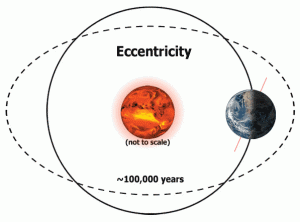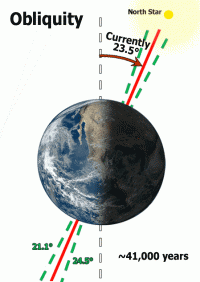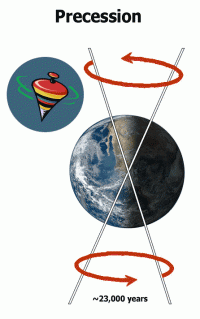The Causes of Glaciation
Milutin Milankovitch (1879-1958) was a Serbian mathematician who, for more than 25 years, worked on producing the first numerical estimates of the effect of variations in Earth's orbit on the latitudinal and seasonal variations in solar radiation. Today, his theory is the most widely accepted explanation for the cause of glaciations. The Milankovitch Theory explains the 3 cyclical changes in Earth's orbit and tilt that cause the climate fluctuations occuring over tens of thousands of years to hundreds of thousands of years. These fluctuations include changes in the shape (eccentricity) of Earth's orbit, the tilt (obliquity) of Earth's axis, and the wobbling (precession) of Earth's axis.
First, Earth's orbit can be nearly circular, as it is presently, or more elliptical. This orbital change from circular to more elongated, is known as eccentricity and takes about 100,000 years to go from nearly circular to elliptical and back to nearly circular in shape. When the orbit is more circular, as it is now, there is less variation in the distance between the sun and Earth. When the orbit is more elliptical, glaciation is affected by the time of year (season) that Earth is closest to the sun.
The second change is in the tilt of Earth's axis, known as obliquity, which varies between 22.1° and 24.5° every 41,000 years. As you have learned, Earth's axis is currently tilted 23.5°. When the tilt is less, the winters are not as cold and the summers are not as warm. Warmer air can hold more water vapor and therefore, produce more snow during the winter months. Because the summers are not as warm, the previous winter's snow does not melt. This promotes glacier formation.
The third change is in Earth's axis. Each 24 hours, Earth rotates once around its imaginary axis. About every 23,000 years, the axis itself also makes a complete circle or precession, causing Earth to “wobble.” This “wobble,” causes Earth to be closer to the sun in July instead of January and intensifies the summer temperatures in the Northern Hemisphere. Because the Northern Hemisphere has more landmasses at higher latitudes where ice sheets can form and grow, the position of this hemisphere is important.
The interplay of these three cyclical changes affects the amount of solar radiation that Earth receives at different latitudes and during different seasons. Currently, we are in a period of relatively small variations in solar radiation, and scientists do not predict a new ice age for 50,000 years.




